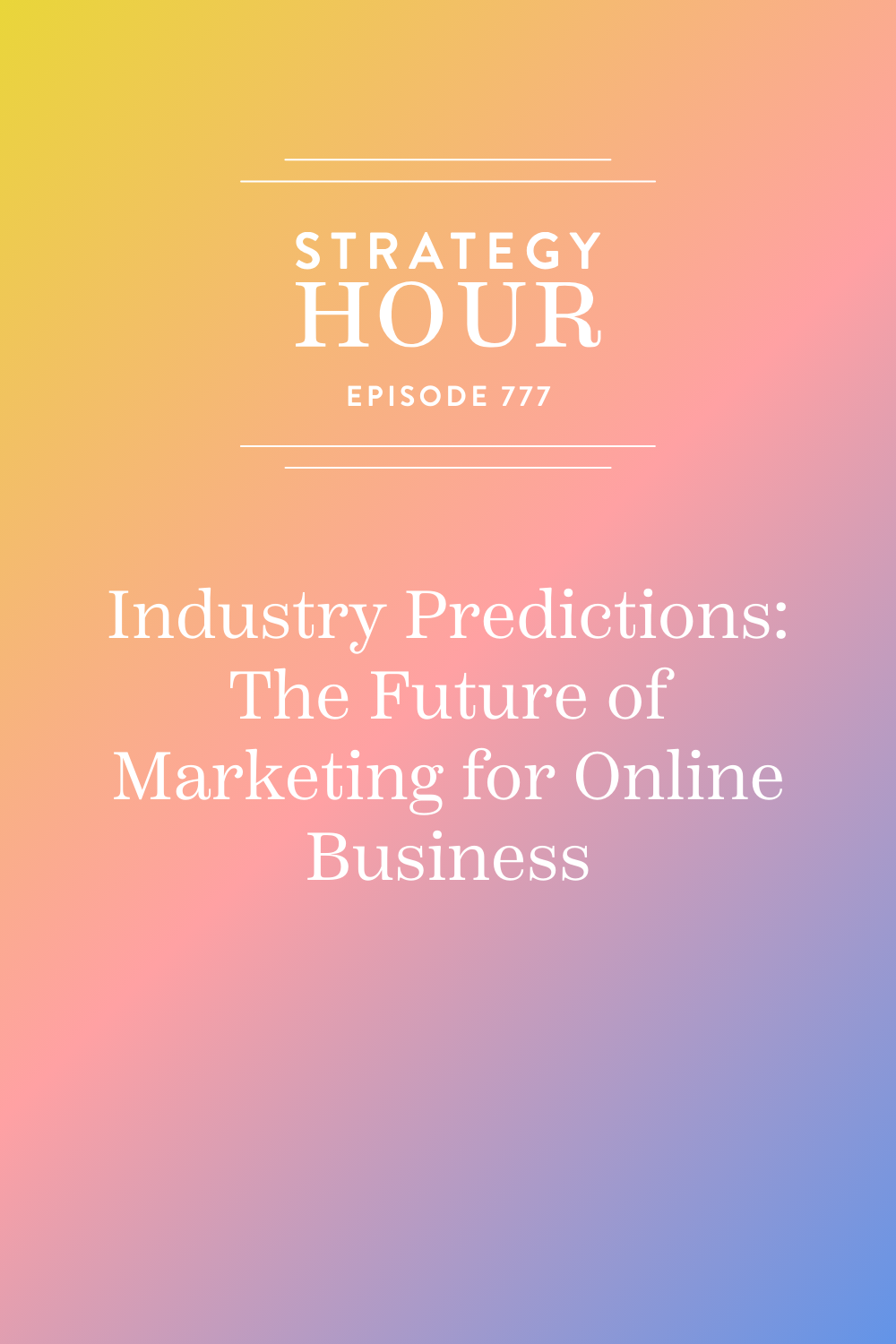Industry Predictions: The Future of Marketing for Online Business
Episode 777: Show Notes
In our last episode, Mariah Coz joined me to discuss our predictions for what the future of online business could look like. Today’s episode continues where we left off and gets into how these predictions will impact marketing in the online business world.
Tuning in, you’ll learn why there’s no one-size-fits-all approach to marketing, and how you should tailor your marketing strategy depending on your business model, whether that’s one-to-one, hybrid, or one-to-many. I unpack the answers to some commonly asked questions, including how niche you should go and how to identify who you’re talking to, before taking a look at how audiences have changed over the past few years. You’ll also find out how your audience impacts your efforts to be more visible and nurture leads, plus advice on what you can do to take your next steps!
I want you to market your business in a way that works for YOU, not just now, but also in the future. So, join me as I break down everything you need to know about the future of marketing for online businesses!
One Size Does Not Fit All
There is no one-size-fits-all approach when it comes to marketing, and there is no singular method that works for all business types. After all, every model operates differently and requires different amounts of people and conversions for it to work. Because of that, your marketing approach should be based on YOUR business model, whether that’s one-on-one, hybrid, or one-to-many. Remember, your business doesn’t need to stick to one model indefinitely. You can evolve and adapt over time, as long as you do so intentionally! So, what should your marketing strategy be when it comes to each of these models?
Which Model is Your Business?
One-on-One
In a one-on-one business, you’re primarily selling to another individual or another business (B2B or B2C), which means that your marketing mainly needs to be interpersonal. It's not necessarily about having marketing channels, social media, or even content. You can have those things, but they are not required for you to succeed in a one-on-one business. It is possible for you to be completely booked out through relationships, referrals, and quality conversions instead!
Hybrid
When it comes to a hybrid business model, building an audience is essential. In this model, you’re starting to offer things in a group setting, like a group coaching program or something similar. You don't necessarily need a huge audience for a hybrid or group program to work. I’ve seen people doing well with as few as 1,000 to 1,500 followers, but it does take time. And you are going to have to grow your audience as you progress. Because when you stop building an audience to sell to, you're going to run out of people to sell to.
One-to-Many
With a one-to-many model, you are going to need broad audience growth and you're going to need a consistent way to continue to build that audience pretty rapidly. In most scenarios, if you're selling exclusively one-to-many, then you are going to need thousands of people in your audience. So, if you're thinking about evolving from a one-on-one business model to a one-to-many, then you need to ensure that audience growth is a key part of your marketing strategy.
Niching Your Audience and Your Offer
How does your model affect who you are talking to? In one-on-one, the strategy I’ve seen convert most smoothly and give people the easiest “yes” is a specific offer for a very specific audience. Because when you're talking to that very specific person, you can speak to their unique pain point. Knowing what that individual is going through is going to make it so much easier to sell!
When it comes to running a hybrid or group business, you will need to either broaden the solution or broaden the audience. However, I would not recommend both. Doing both makes it much harder for people to know whether or not your offer is for them.
For one-to-many, what I’ve seen working really well is solving a super-specific problem for a much broader audience. Positioning yourself as selling an all-in-one solution for an all-in-one audience is not selling the way that it used to! This tells us that you really need to be able to speak to the specific problem that you're solving and demonstrate what life will look like for your audience after you solve it for them.
The Partnership Between Visibility and Nurture Channels
If you know you need to change your audience and who you’re talking to, how does that affect how you should approach visibility and nurture? And what is the difference between the two?
Creating visibility is inherently different from nurturing your audience. Visibility is about discovery. It's where people can find you for the first time. It’s also where they connect with you and have the opportunity to be introduced to a new offering they haven’t encountered before and get excited about it! Bear in mind that they’re not necessarily going to convert immediately, which is fine because that’s not the point. This is where your nurture channels come into play!
Nurture channels are where people go from learning about you to feeling like they can trust you and explore their interest in buying from you. Nurture channels typically have a gateway from a visibility channel, like jumping on someone’s email list after reading their blog content or signing up for a workshop after seeing their videos on TikTok. In these channels, you should be focusing on content that makes people feel understood. You want to make sure that people feel heard. You want them to understand that you see them, you know what they're going through, and you are there to serve them!
How Audiences Have Changed
People are much more aware of marketing these days and it has changed the way they interact with brands and offerings. In the past, potential customers would typically be 50 to 60% sure of their decision to buy before reaching out. These days, audiences are far more likely to be 90 to 95% ready for a sale before they do outreach. They also want to be able to find answers without having to talk to other people, so make sure you don’t bury the lead and that they are able to find all the answers they need quickly and easily. If you make that information hard to find, potential customers are going to give up, move on, and buy from someone else!
How To Take the Next Step
When it comes to marketing your online business, I want to make it as easy as possible for you to take the next step. That’s why I’ve taken my recent workshop and made it available to anyone who wants to watch the replay on demand! If you’re interested in deepening your knowledge of how selling works, how your offer works, and how pricing works differently depending on your model, then this workshop is going to be immensely useful in helping you to take the next step!
I'm so excited about everything we're working on and rolling out for all of you — and there's so much more to come! Watch our seminar now to learn more about everything we’ve discussed today and find out how you can take the next step in marketing your online business!
Quote This
I'm here to give you the honest truth about the different approaches you could take to market your business, and how that might change over time.
Highlights
One Size Does Not Fit All [0:03:27]
Which Model is Your Business? [0:05:22]
Niching Your Audience and Your Offer [0:13:48]
The Partnership Between Visibility and Nurture Channels [0:24:11]
How Audiences Have Changed [0:37:54]
How To Take the Next Step [0:42:47]
OUR HOST:
Abagail Pumphrey
Boss Project on Instagram | Facebook
Abagail Pumphrey, the Co-Founder & CEO of Boss Project, has been a driving force in the creative entrepreneur industry since 2015. With a passion for empowering service-based business owners around the globe, she became internet-famous after the launch of the transformative training, "Trello for Business." This innovative system revitalized the operations of over 10,000 business owners, making a significant impact on the online business landscape.
Under Abagail's leadership, Boss Project has been featured in prestigious publications such as Forbes, Marie Claire, INC, and HuffPost. Her twice-weekly podcast, The Strategy Hour, is a staple in the business community, continuously topping Business and Management Charts on Apple with millions of listeners from around the world.
Abagail's superpower lies in her ability to break down complex concepts into easy-to-implement, duplicatable systems. As an expert in online sales and a data-driven strategist, she has turned a layoff into a 7-figure work-from-home business. Abagail's mission to help more female founders become financially free, without letting their businesses take over their lives, continues to inspire and guide entrepreneurs on their path to success.
Key Topics:
Business Models, One-to-one, Hybrid, One-to-many, Marketing Online Businesses




